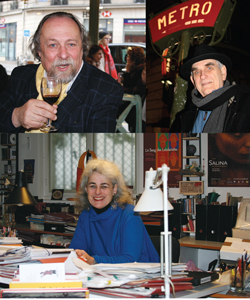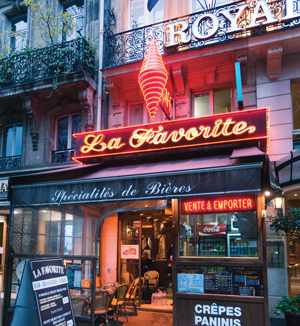In the right light, the shadow of the Eiffel Tower looms like Mount Tamalpais against the green of the Champs de Mars. It’s not so unusual for some Paris residents to be reminded of the Marin mountain while they’re knocking around the French capital. Take William Martz, former publisher of the English-language Paris Magazine. He knows Mount Tam because it’s close to his Mill Valley home. What is unusual is that Martz is just one of a cadre of people with Mill Valley roots who have carved out an unmistakable niche in the City of Light. From artist to physics teacher to raconteur, each has experienced the mesmerizing alchemy of two apparently disparate towns that could be the most beautiful spots on the planet.
Paris, Mon Amour
Ask Ken Varcoe what brings him from Mill Valley to Paris, and he’ll offer a characteristically California response: “Karma.”
Varcoe has a particularly intimate connection to Paris—he married a Parisienne. The former computer salesman met his wife, Josette, in 1987 on a flight to India when he was a single dad with two young sons. The couple started chatting and discovered they had the same guru. Now that the boys are long grown, the 60-something perennial truth-seeker spends close to eight months a year in Paris. His wife works as a psychotherapist, and he runs the Paris vacation rental operation that his spouse started in their Mill Valley home as a favor to friends.
As manager of Paris by Heart, Varcoe leases out city apartments owned by Yanks, Brits, Aussies and New Zealanders to their sojourning compatriots. But, truth be told, Varcoe prefers Mill Valley.
“We don’t really drink, and my wife’s a great cook—so we don’t go out to eat much here,” he says, sitting in a Montmartre coffee shop that could be a restaurant straight out of Amélie. “I’m American through and through and through—a Connecticut Yankee—and Mill Valley is the best of America,” he says, wistfully. “It’s beautiful; people greet you warmly and sincerely.”
Even his Parisian-to-the-bone wife is besotted with Marin and has several favorite haunts: Green Gulch, Muir Beach, Blackie’s Pasture, Sushi Ran and the Buckeye. Still, Varcoe spends months in Paris because he yearns to be at his wife’s side, and her blood still quickens to the strains of Edith Piaf. “You can take the girl out of Paris, but you can’t get Paris out of the girl,” he observes.
What’s the first thing he does when he’s back in Mill Valley? “I’m a creature of habit,” he says. “I head to La Coppa, the coffee shop on the square. I have my newspaper tucked under my arm, I sit down with my drink, and I’m set.” Is the Mill Valley coffee shop crowd curious about Paris? “They ask me what’s the best time to visit Paris.” He laughs. “I tell them: ‘After you’ve won the lotto.’ ”
The Other Left Bank
 Gadabout and Jacques-of-many-trades Terrance Gelenter is talking like an American—loudly—and enjoying a favorite mid-afternoon French snack of potato chips with a Bordeaux chaser on a recent sunny afternoon. Contrary to stereotype, Parisians crowded around at Le Danton on the Left Bank (Paris, not Larkspur) smile warmly and banter with Gelenter when he jokes in French about the jammed tables or asks the waiter to pose for a photo.
Gadabout and Jacques-of-many-trades Terrance Gelenter is talking like an American—loudly—and enjoying a favorite mid-afternoon French snack of potato chips with a Bordeaux chaser on a recent sunny afternoon. Contrary to stereotype, Parisians crowded around at Le Danton on the Left Bank (Paris, not Larkspur) smile warmly and banter with Gelenter when he jokes in French about the jammed tables or asks the waiter to pose for a photo.
“That’s what I love about Parisians,” he says. “They accept you for who you are—and I don’t have to edit myself.” Though Gelenter lived 17 years in Mill Valley and still keeps a toe in a pied-à-terre there, he’s beginning to feel more chez moi in Paris and more étranger in Mill Valley. “Seems like you need a child or a dog to fit in back there now,” he says.
Gelenter raised his family in San Rafael and Mill Valley, working as a media buyer and a Spanish-language film reviewer under the pseudonym Guillermo Medina. Now, he has remade himself as an author and go-to guy for U.S. tourists and expats in Paris: he hosts periodic networking soirees featuring journalists and other speakers, leads daylong tours and market trips, arranges readings for visiting authors and plans to launch a retro film series. Gelenter first visited Paris as a young man and eventually became hooked. “It’s like being in love,” he says. “You can’t quite explain why, but everything in life is better. It’s how she makes you feel.”
When it comes to Marin, he yearns for an old Mill Valley that encapsulated the “best of hippiedom without the drugs,” but he still sees a profound connection between his two homes. “There’s a certain sensibility of people who have elected to live in Mill Valley that gives the town a very different face than the rest of the country,” he muses. The two towns might also be said to have a strain of hedonism in common, “and definitely an appreciation of food,” he adds. “The [custom] of eating healthy, seasonal, local food is very European; you go to the market and see what looks good.”
Walking is another avocation shared by flaneurs in both locations. Gelenter walks everywhere in Paris, and last time he was in Cascade Canyon he spent a pleasurable day “sucking in the oxygen.” His hand caresses a wineglass as he recalls the day, talking of the Mill Valley woods as if they’re just across the Seine.
Proustian Memories
It’s been 20 years since artist Karen Sheckler-Wilson moved to Paris. She eventually became a French citizen, but “my heart is in Mill Valley,” she says. “There are times when I smell eucalyptus, and my whole childhood comes rushing back to me.”
Sheckler-Wilson grew up above the Mill Valley Tennis Club, where she swam to near exhaustion on long summer days until her mom hung a beach towel from a railing on their Manor Hill home that she could spot from the pool. That was her signal to come home for dinner.
Mill Valley was a “sensual, stunningly beautiful town,” she notes, perfect for raising kids but cosmopolitan, too—a place where her Viennese mother and European friends felt welcome and comfortable. Her own favorite haunts? “Definitely Baskin-Robbins—it was far enough away that it was an adventure. And the library; that was a bike ride.”
Despite the fond memories, it was to Paris, where she had studied art, that Sheckler-Wilson chose to move with her husband, James, a composer, teacher and guitar player, to start a family and launch her design business. She felt safer in Europe. She has a touch of fear when she thinks of California, having lived in Mill Valley during the era of the Zodiac Killer. She remembers school drills when students were told to drop to the floor if bus tires popped, because the Zodiac had threatened to fire on school bus wheels, then shoot the children. Later, while she was studying art in Pasadena, the Hillside Strangler was stalking women in Southern California. She never worried that stranglers would attack her two daughters in Paris. Still, the Bay Area reminds her of Europe in other ways.
“It’s visually stunning, and there’s something about it that’s very continental,” she says. “It’s the human scale, and the appreciation of beauty, food and culture. It’s exciting, but with a softer buzz.” She says she’ll likely stay abroad for the rest of her life, but “I want my ashes scattered under the Golden Gate.”
Stinson on the Seine
 What do a student film festival, Mill Valley’s Scout Hall and the subject of physics all have in common? The answer is Laura Schupack, a 20-year physics teacher and now film instructor at the American School of Paris. Growing up in the wilds of Blithedale Canyon, Schupack developed a love of hiking and movies in the early years of the Mill Valley Film Festival. “We set up folding chairs in Scout Hall and watched the films on a roll-up screen.”
What do a student film festival, Mill Valley’s Scout Hall and the subject of physics all have in common? The answer is Laura Schupack, a 20-year physics teacher and now film instructor at the American School of Paris. Growing up in the wilds of Blithedale Canyon, Schupack developed a love of hiking and movies in the early years of the Mill Valley Film Festival. “We set up folding chairs in Scout Hall and watched the films on a roll-up screen.”
Who knew that experience would lead the popular teacher to launch the European Student Film Festival, hosted for the first two years at the St. Cloud campus of the American School of Paris? This year, some of the best high school student films from around the world will be screened at the festival in Prague. “Filmmaking [here] was really a project spearheaded by students at the American School of Paris,” says Schupack. “I started the festival, invited experts from top film schools to speak and learned right along with the students.”
Schupack has no doubt that her formative years in Mill Valley, from toddler to Tam High grad, helped shape her interests and her future. Now, with a French husband and sons, she’s unlikely to ever move away from Paris, but she has a soft spot for her Marin hometown. “I loved being outdoors,” she recalls. “It was also an exciting time with the [cultural] flux of the ’60s and rock bands in the area like the Grateful Dead. Mill Valley had a special quirkiness. My mom raised ducks and chickens and rabbits (never to eat!) and that was OK with people because of that weirdness of Mill Valley.”
Schupack left Marin for Paris on a whim, planning to share an apartment with a college pal, after graduating with a science degree from Yale. She soon found a job teaching at the International School in Paris, advertised on a sticky-note on a church bulletin board. She returned briefly to Berkeley for grad school and eventually earned a doctorate at the Pasteur Institute in Paris—but was again lured from the lab to the classroom, this time at the American School.
The two cities are “so different,” she notes. “One is very urban, the other almost rural.” Still, she sees them as somehow kindred towns: “There’s a remarkable quality of life in both places, as well as respect for the art and an awareness of different cultures.” And while nothing quite surpasses the sight of the sun setting over the Seine, she says, “there are few places on the planet where you can walk out your door into the woods and hike to Stinson Beach.”


